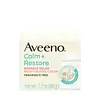What's inside
What's inside
 Key Ingredients
Key Ingredients

 Benefits
Benefits

 Concerns
Concerns

 Ingredients Side-by-side
Ingredients Side-by-side

Water
Skin ConditioningGlycerin
HumectantC12-15 Alkyl Benzoate
AntimicrobialCetearyl Alcohol
EmollientDimethicone
EmollientArachidyl Alcohol
EmollientCetyl Alcohol
EmollientAvena Sativa Kernel Flour
AbrasivePhenyl Trimethicone
Skin ConditioningCetearyl Glucoside
EmulsifyingBehenyl Alcohol
EmollientSodium Polyacrylate
AbsorbentPhenoxyethanol
PreservativePanthenol
Skin ConditioningCaprylyl Glycol
EmollientEthylene/Acrylic Acid Copolymer
Emulsion StabilisingPolyacrylamide
Arachidyl Glucoside
EmulsifyingC13-14 Isoparaffin
EmollientChrysanthemum Parthenium Flower/Leaf/Stem Juice
AntioxidantChlorphenesin
AntimicrobialDisodium EDTA
Pentaerythrityl Tetra-Di-T-Butyl Hydroxyhydrocinnamate
AntioxidantLaureth-7
EmulsifyingCeramide NP
Skin ConditioningWater, Glycerin, C12-15 Alkyl Benzoate, Cetearyl Alcohol, Dimethicone, Arachidyl Alcohol, Cetyl Alcohol, Avena Sativa Kernel Flour, Phenyl Trimethicone, Cetearyl Glucoside, Behenyl Alcohol, Sodium Polyacrylate, Phenoxyethanol, Panthenol, Caprylyl Glycol, Ethylene/Acrylic Acid Copolymer, Polyacrylamide, Arachidyl Glucoside, C13-14 Isoparaffin, Chrysanthemum Parthenium Flower/Leaf/Stem Juice, Chlorphenesin, Disodium EDTA, Pentaerythrityl Tetra-Di-T-Butyl Hydroxyhydrocinnamate, Laureth-7, Ceramide NP
Water
Skin ConditioningXylitol
HumectantGlycerin
HumectantButyrospermum Parkii Butter
Skin ConditioningOleyl Erucate
EmollientPropanediol
SolventMyristyl Myristate
EmollientShea Butter Ethyl Esters
EmollientVaccinium Myrtillus Fruit Juice
Skin ConditioningC12-16 Alcohols
EmollientCanola Oil
EmollientPentylene Glycol
Skin ConditioningGlyceryl Stearate
EmollientCetyl Alcohol
EmollientBetaine
HumectantAvena Sativa Kernel Oil
Skin ConditioningAvena Sativa Kernel Extract
AbrasiveInulin
Skin ConditioningHydrogenated Oat Kernel Oil
EmollientVaccinium Myrtillus Seed Oil
Skin ConditioningCeramide NP
Skin ConditioningCeramide AP
Skin ConditioningPhytosphingosine
Skin ConditioningCholesterol
EmollientCeramide EOP
Skin ConditioningHydrogenated Lecithin
EmulsifyingPalmitic Acid
EmollientTocopherol
AntioxidantSaccharide Isomerate
HumectantCetearyl Alcohol
EmollientBrassica Campestris Sterols
EmollientEthylhexylglycerin
Skin ConditioningHydroxyacetophenone
AntioxidantHelianthus Annuus Seed Oil
EmollientSodium Gluconate
Skin ConditioningSclerotium Gum
Emulsion StabilisingPhenoxyethanol
PreservativeCetyl Hydroxyethylcellulose
Emulsion StabilisingPolyglyceryl-10 Stearate
Skin ConditioningTriethyl Citrate
MaskingPolyglyceryl-6 Behenate
Emulsion StabilisingCitric Acid
BufferingSodium Citrate
BufferingSodium Carrageenan
Emulsion StabilisingBehenic Acid
CleansingSodium Levulinate
Skin ConditioningPotassium Sorbate
PreservativeMaris Sal
Skin ConditioningDisodium Phosphate
BufferingHydrated Silica
AbrasiveSilica Dimethyl Silylate
EmollientSodium Cetearyl Sulfate
CleansingRosmarinus Officinalis Leaf Extract
AntimicrobialWater, Xylitol, Glycerin, Butyrospermum Parkii Butter, Oleyl Erucate, Propanediol, Myristyl Myristate, Shea Butter Ethyl Esters, Vaccinium Myrtillus Fruit Juice, C12-16 Alcohols, Canola Oil, Pentylene Glycol, Glyceryl Stearate, Cetyl Alcohol, Betaine, Avena Sativa Kernel Oil, Avena Sativa Kernel Extract, Inulin, Hydrogenated Oat Kernel Oil, Vaccinium Myrtillus Seed Oil, Ceramide NP, Ceramide AP, Phytosphingosine, Cholesterol, Ceramide EOP, Hydrogenated Lecithin, Palmitic Acid, Tocopherol, Saccharide Isomerate, Cetearyl Alcohol, Brassica Campestris Sterols, Ethylhexylglycerin, Hydroxyacetophenone, Helianthus Annuus Seed Oil, Sodium Gluconate, Sclerotium Gum, Phenoxyethanol, Cetyl Hydroxyethylcellulose, Polyglyceryl-10 Stearate, Triethyl Citrate, Polyglyceryl-6 Behenate, Citric Acid, Sodium Citrate, Sodium Carrageenan, Behenic Acid, Sodium Levulinate, Potassium Sorbate, Maris Sal, Disodium Phosphate, Hydrated Silica, Silica Dimethyl Silylate, Sodium Cetearyl Sulfate, Rosmarinus Officinalis Leaf Extract
 Reviews
Reviews

Ingredients Explained
These ingredients are found in both products.
Ingredients higher up in an ingredient list are typically present in a larger amount.
Ceramide NP is a type of ceramide and formally known as ceramide 3.
Ceramides are intercellular lipids naturally found in our skin that bonds dead skin cells together to create a barrier. They are known for their ability to hold water and thus are a great ingredient for dry skin.
Ceramides are an important building block for our skin barrier. A stronger barrier helps the skin look more firm and hydrated. By bolstering the skin ceramides act as a barrier against irritating ingredients. This can help with inflammation as well.
If you would like to eat ceramides, sweet potatoes contain a small amount.
Read more about other common types of ceramides here:
Ceramide AP
Ceramide EOP
Cetearyl alcohol is a mixture of two fatty alcohols: cetyl alcohol and stearyl alcohol. It is mainly used as an emulsifier. Emulsifiers help prevent the separation of oils and products. Due to its composition, it can also be used to thicken a product or help create foam.
Cetearyl alcohol is an emollient. Emollients help soothe and hydrate the skin by trapping moisture.
Studies show Cetearyl alcohol is non-toxic and non-irritating. The FDA allows products labeled "alcohol-free" to have fatty alcohols.
This ingredient is usually derived from plant oils such as palm, vegetable, or coconut oils. There is debate on whether this ingredient will cause acne.
Due to the fatty acid base, this ingredient may not be Malassezia folliculitis safe.
Learn more about Cetearyl AlcoholCetyl Alcohol is a fatty alcohol. Fatty Alcohols are most often used as an emollient or to thicken a product.
Its main roles are:
Though it has "alcohol" in the name, it is not related to denatured alcohol or ethyl alcohol.
The FDA allows products labeled "alcohol-free" to have fatty alcohols.
Learn more about Cetyl AlcoholGlycerin is already naturally found in your skin. It helps moisturize and protect your skin.
A study from 2016 found glycerin to be more effective as a humectant than AHAs and hyaluronic acid.
As a humectant, it helps the skin stay hydrated by pulling moisture to your skin. The low molecular weight of glycerin allows it to pull moisture into the deeper layers of your skin.
Hydrated skin improves your skin barrier; Your skin barrier helps protect against irritants and bacteria.
Glycerin has also been found to have antimicrobial and antiviral properties. Due to these properties, glycerin is often used in wound and burn treatments.
In cosmetics, glycerin is usually derived from plants such as soybean or palm. However, it can also be sourced from animals, such as tallow or animal fat.
This ingredient is organic, colorless, odorless, and non-toxic.
Glycerin is the name for this ingredient in American English. British English uses Glycerol/Glycerine.
Learn more about GlycerinPhenoxyethanol is a preservative that has germicide, antimicrobial, and aromatic properties. Studies show that phenoxyethanol can prevent microbial growth. By itself, it has a scent that is similar to that of a rose.
It's often used in formulations along with Caprylyl Glycol to preserve the shelf life of products.
Water. It's the most common cosmetic ingredient of all. You'll usually see it at the top of ingredient lists, meaning that it makes up the largest part of the product.
So why is it so popular? Water most often acts as a solvent - this means that it helps dissolve other ingredients into the formulation.
You'll also recognize water as that liquid we all need to stay alive. If you see this, drink a glass of water. Stay hydrated!
Learn more about Water